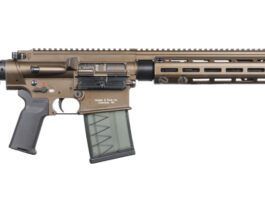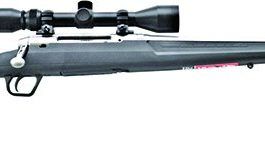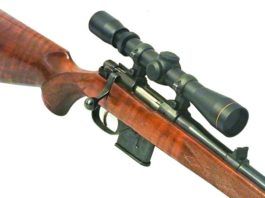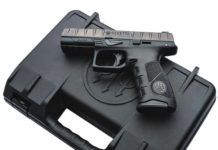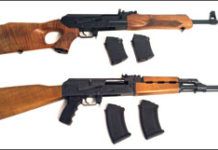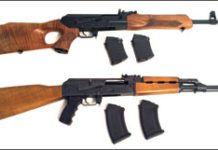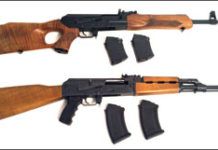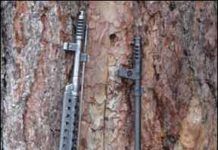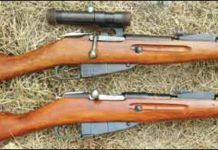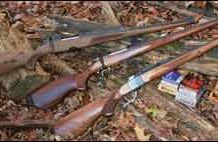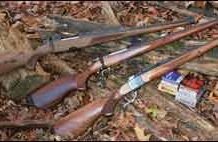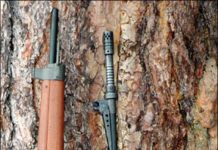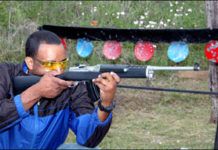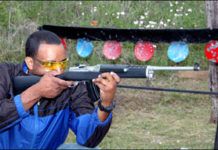Beretta Unveils APX Striker Gun
Beretta's APX, a new striker-fired full-size pistol in 9x19mm, 9x21mm IMI and 40 Smith & Wesson cartridges, debuted at the 2015 International Defence Exhibition & Conference IDEX expo in Abu Dhabi Feb. 22.
"IDEX is one of the first venues where defense contractors present their wares to worldwide military customers and Beretta felt this was the ideal environment to present the international offering of its APX pistol," said Carlo Ferlito, general manager of Beretta and Beretta Defense Technologies (BDT) vice president.
Beretta intends to market a variant for the commercial market later this year. The new Beretta APX has an ergonomically-molded reinforced polymer frame fitted with a built-in MIL-STD-1913 Picatinny rail, interchangable backstraps and grip panels, and a modified Browning locking system. The APX is 7.56 inches long with a 4.25-inch barrel.
The trigger can be considered a light double action, with a 6-pound break, 0.2 inch of travel, and a 0.12-inch reset. The rear portion of the striker slightly protrudes from a round slot on the back of the slide as a loaded-chamber indicator.
The slide is machined from stainless steel and has a nitride coating that reduces glare, scratches, and corrosion. Other features include wide front and rear slide serrations, three-dot sights dovetailed into the slide, and no manual safety save for a Glock-style trigger safety.
Ferlito said, "Beretta waited to enter the striker-fired market until we had a pistol we knew would meet the needs of the operator. The APX has been more than three years in development. We tested it extensively with professional end users and incorporated that feedback at every opportunity. The result is a pistol platform that delivers superior performance in durability, reliability, accuracy and ergonomics."
A slot on the frame allows the use of a tool to decock it before it can be field-stripped by operating a lever found on the left side of the frame.
An optional manual safety system will be available upon request, consisting of a frame-mounted two-position switch. A reversible magazine-release catch and a factory ambidextrous slide stop/hold open release lever help make the pistol suitable for left- or right-handed shooters.
Supplied black double-stack metal magazines have polymer bottom pads and offer 17-round capacities in 9x19mm NATO and 15-round capacities in 9x21mm IMI (9 Italian) and 40 Smith & Wesson.
Lo-Cap AK-47s: We Compare K-VAR VEPR, CIA N-PAP Rifles
Lo-Cap AK-47s: We Compare K-VAR VEPR, CIA N-PAP Rifles
Lo-Cap AK-47s: We Compare K-VAR VEPR, CIA N-PAP Rifles
Two 7.62x54R Semiauto Rifles: Surplus Tokarev Beats PSL-54C
Classic Military Bolt-Action Rifle Shootout: Lee Enfield Wins
During World War I and World War II, and in some cases beyond, there came four great bolt-action rifles in martial actions: the Lee Enfield, the Mauser, the Mosin Nagant and the Springfield. While there were many variations among the rifles, we all know what a Lee Enfield and a Mauser look like. The Nagant was produced in the many millions, and the Springfield is sometimes regarded as a rifle with almost magical accuracy. These rifles wrought many a bloody victory for one side or the other in warfare from about 1903 onward. The Lee Enfield and Mauser rifles are still seen in action in Afghanistan today. Recent events in India showed Indian security forces armed with the Lee Enfield, probably a homegrown version. These rifles simply refuse to die. While these four are the great battle rifles of the 20th century, there were other contenders for the test program that were considered and discarded. The excellent Schmidt Rubin straight-pull rifle was considered, but since it didn't figure into warfare it was not included. The French rifles are a bit quirky for our tastes, and ammunition is difficult to obtain. Likewise, the Italian Carcano is not really in the league with the others. We admit the Japanese Arisaka is an omission, but we were unable to find a suitable firing version within our time frame. We used four rifles primarily during the test program and added two special interest rifles for a side comparison as well. In the end we think we have a good idea of the handling properties of the rifles used in the Great Wars.
Mosin Nagants: We Pit Two Versions of the Hoary 1891/30
The ancient Mosin Nagant rifle has a storied history. It was the first magazine rifle adopted by Russia, back in 1891. The early versions harked back to Civil War rifles as to overall length. The first version of the rifle was over 50 inches long, and by 1930, as with our test rifles, the length is still over 4 feet. Add a bayonet and the gun resembles a spear more than a modern rifle. However, the basic design is still being used by many troops who need a stout bolt-action rifle, well over a century after its introduction. The Mosin Nagant will never win any beauty contest, mostly because of its drop-down magazine, and we don't know of any custom sporters built on them, though they surely exist. However ugly the rifle may be, it has served long and well as a prime military weapon.
In this report we tried to find out how good a military rifle the 1930 variant was, and if it was any better with a scope. To that end, we acquired two of the long Model 1891/30 rifles, which designation indicates the original design was seriously modified in 1930. One of our test rifles was a common variety and the other, the "sniper" version with a reproduction period scope. The two rifles came with a package of bayonet, sling, and cleaning materials. We tested them with three bullet types and weights, 150-grain soft-point boattail, 182-grain FMJ BT, and 203-grain soft point. The first two types of our test ammo were made by the Serbian Prvi Partizan company, and the third by Brown Bear, out of Russia. Here's what we found.
Mannlicher-Style Hunting Rifles: CZ Outduels Ruger and Steyr
Mannlicher-Style Hunting Rifles: CZ Outduels Ruger and Steyr
French MAS Semiautos: History-Making Rifles Compete
Long before WWI the French were hard at work on semiauto rifle designs. Unfortunately they didn't have much in production at the start of the Great War, so they fought that war largely like the rest of the world did, with bolt-action rifles. It was not until 1949 that France had its own successful semiauto rifle in the MAS, chambered for the 7.5x54mm cartridge, which is similar to the 7.62 NATO round. That rifle was designated the Model 1949, and it incorporated some features of the bolt-action Model 1936, including its cartridge, rear-sight arrangement and two-piece stock. Later modifications developed the M1949 into the Model 1949-56. For this report we acquired one of each type from Collectors Firearms (www.collectorsfirearms.com), the M1949 chambered for the original cartridge and the ‘49-56 rechambered by some arsenal to 7.62 NATO. The French cartridge is a bit longer and very slightly fatter than the NATO cartridge, so we presume the barrel had to be set rearwards to effect the conversion.
MAS stands for Manufacture Nationale d'Armes de St-Etienne. This is a gas-driven design that would be familiar to the fans of the various AR-15/M-16 rifles. The gas tube impinges directly on the bolt carrier, blowing it rearward with each shot. There are no moving parts, like pistons or pushrods, in the gas system.
Although the rifles had essentially the same actions, the M1949 had only a stacking lug at the front and no muzzle brake, presenting what amounted to a naked barrel muzzle. The ‘49-56 had a grenade launcher, muzzle brake/flash hider, and folding grenade sights. The rear sight on each rifle was an aperture, adjustable upward from 200 to 1200 yards. The front blade on the M49 was a fixed post, but the later rifle had an elevation-adjustable front post.
The detachable magazines had their clasp as part of the magazine, a simple and rugged system that locked into a notch cut in the right side of the action. The 10-round magazines were interchangeable between our two test rifles. Apparently higher-capacity magazines have been available for the MAS rifles. The original parts kits issued with the rifles apparently were well thought out and included critical spare parts, magazines, bayonet, cleaning stuff, and for some, a compact 3.9X scope. All the MAS rifles have a rail on the left side of the action permitting easy scope mounting.
The later rifle had a larger trigger guard, permitting firing with gloves. Both rifles had a simple leather sling attached to the left side of the rifle. The 49-56 had a black slip-on recoil pad, apparently original issue.
Each rifle had a two-piece hardwood stock with a wood hand guard covering the forward part of the barrel and the gas tube. The woods were plain walnut and birch. The safety consisted of a lever located to the right front of the trigger guard. In the safe position it partially obscured the trigger opening, which was more obvious for right handers. Both bolts had a serrated white plastic covering on the bolt knob. The actions were solid, well-made, nicely machined items that looked to be extremely strong. There were no plastic nor flimsy metal parts anywhere on either rifle. These were serious war-time rifles made to work and to last.
Takedown for these rifles was remarkably simple. After clearing the rifle, remove the magazine and let the slide go forward. Then slide the large button at the rear of the receiver downward, toward the wrist of the rifle. Press forward on the top-rear portion of the action, which is the cover, and when it moves just over half an inch toward the front of the rifle it can be lifted off toward the rear, releasing tension on the recoil spring. Then slide the bolt carrier rearward until the bolt and carrier are all the way back, and they can then be lifted out. That's it. With a normal cleaning rod the barrel must be cleaned from the front. For reassembly reverse the process. You have to fight the spring a bit, but it's an easy job. If you have to remove the trigger assembly, you'll need a screwdriver to remove a slotted screw at the rear of the trigger guard.
Largely because of extremely poor winter weather, we tested the two rifles with one type of ammo each. For the Model 1949 we used Serbian Prvi Partizan 139-grain FMJ, and for the 1949-56 we used Magtech 150-grain FMC. Here's what we found.


























